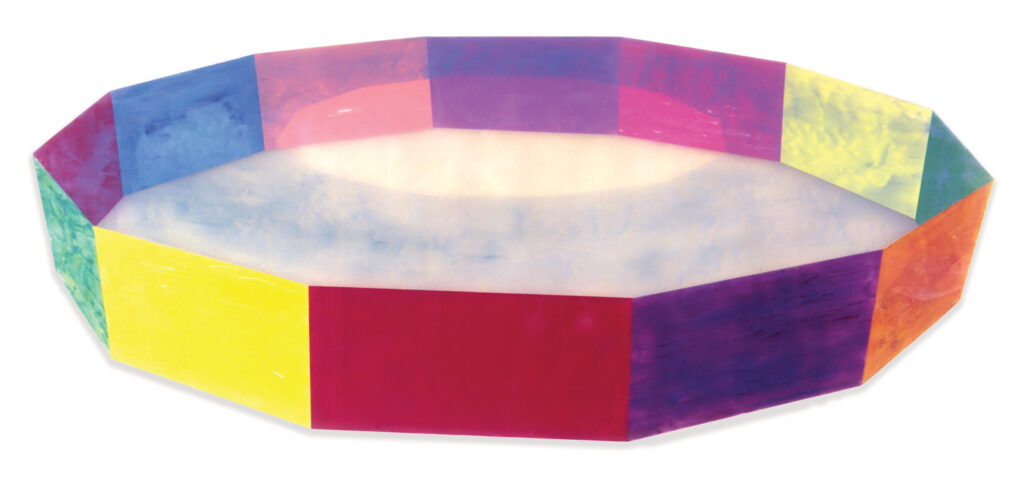Inside Light, 1969 –
Dodecagon Series. Fiberglass and polyester resin.
Ronald Davis was one of the most significant artists to extend the accomplishments of Abstract Expressionism. His geometrically shaped paintings of the late 1960s and early ‘70s utilized new materials and techniques in a uniquely refined fusion of color, perspective, and illusionism. As ‘abstract illusionist’ or ‘lyrical abstractionist’ art, his work debunked the established formalist demand that important abstract painting not be illusionary. Using colored polyester resin and fiberglass, Davis achieved a rhythmic play of spatters and configurations contained by balanced geometric precision. By pouring fiberglass on top of the lush-colored planes of solid and variegated resins—which he would apply to the bottom side of his molds—the color would reside behind the actual glass-like surfaces of the works. This subtle dimensionality, along with the interplay of gloss, color, and perspectival illusionism of form, endow a profound poetry to his work.
 Davis’s aesthetic and technical innovation gave rise to his two most historically recognized groups of work, the Slab Series and the Dodecagon Series, the latter of which includes twenty-eight twelve-sided paintings like Inside Light (in the collection of the Frederick Weisman Foundation Museum, Los Angeles). Because color is not ‘applied’ to the ‘surface’ in any way—like paint on canvas—but instead seems to lie somewhere behind it, and because the paint and the ground (the pigment and the plastic resin) are the same substance, the same surface plain, the Minimalist notion of objecthood is made exquisitely compelling in his work. Not only are Davis’s paintings an illusion of an object; they are affirmed as objects. These works are paradigmatically Californian as well, both with their polished illusionism and impressive use of new materials—specifically those used in surfboards, boats, and automobiles, all a booming West-coast industry.
Davis’s aesthetic and technical innovation gave rise to his two most historically recognized groups of work, the Slab Series and the Dodecagon Series, the latter of which includes twenty-eight twelve-sided paintings like Inside Light (in the collection of the Frederick Weisman Foundation Museum, Los Angeles). Because color is not ‘applied’ to the ‘surface’ in any way—like paint on canvas—but instead seems to lie somewhere behind it, and because the paint and the ground (the pigment and the plastic resin) are the same substance, the same surface plain, the Minimalist notion of objecthood is made exquisitely compelling in his work. Not only are Davis’s paintings an illusion of an object; they are affirmed as objects. These works are paradigmatically Californian as well, both with their polished illusionism and impressive use of new materials—specifically those used in surfboards, boats, and automobiles, all a booming West-coast industry.
Davis was born in California, grew up in Wyoming, studied art in San Francisco, and moved to Los Angeles in 1965, where he developed the fiberglass-resin technique. He continued creating large-scale, geometric and illusionistic art, turning to canvas and acrylic paint in 1972 and later experimenting with encaustic techniques. Proving his remarkable abilities as an innovator, in 1988 Davis began designing his paintings with a Macintosh computer and 3-D rendering and animation programs, a technological application he has used to this day to arrive at his optically lyrical creations.
Inside Light, 1969
60 1/2 x 136 inches, (shaped)
Molded Polyester Resin and Fiberglass, Dodecagon Series, (PTG 0058)
Collection: Frederick R. Weisman, Beverly Hills, CA
Included in the Getty Center’s Pacific Standard Time exhibition at the Frederick R. Weisman Gallery at Pepperdine University, Malibu, October 2011
Included in the solo exhibition, Dodecagons, 1968, Leo Castelli Gallery, New York, October 1968
